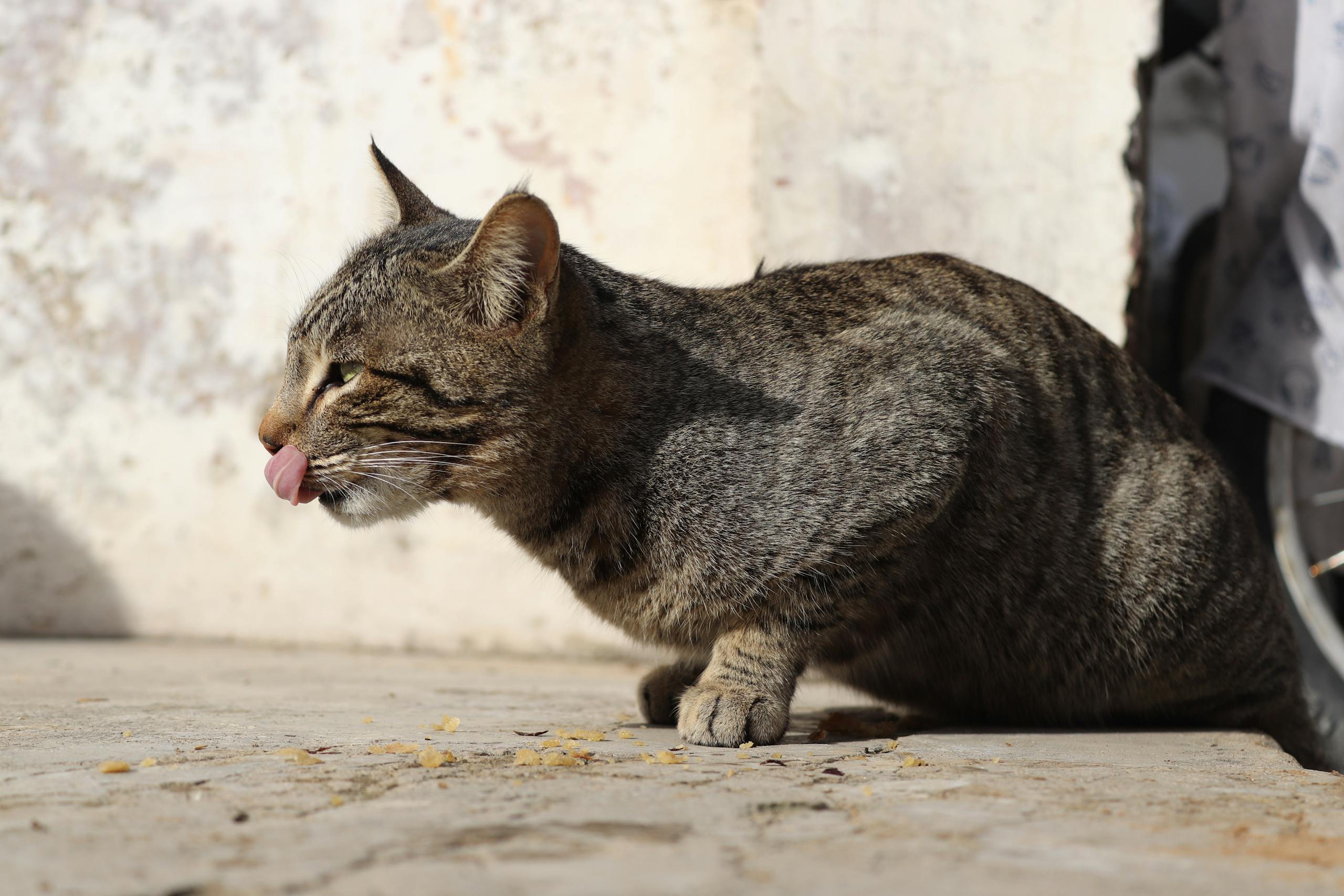Taming Stray Cats – Tips to Calm and Connect | Cat Care Guide
Have you ever tried approaching a stray cat only to have it run away or hiss in fear? Stray cats can be skittish, unpredictable, and even aggressive when they feel threatened.
How do you calm a stray cat that has likely experienced trauma or fear in its past? Is it even possible to build trust with these wary animals? If you’ve ever wondered how to calm down a stray cat and help them feel safe, you’re in the right place.
In this article, we’ll explore effective ways to soothe a stray cat and the signs that show when a cat is fearful. Let’s unlock the secrets of calming stray cats and fostering trust, even in the most anxious felines.
Key Takeaways:
- Knowing the signs of fear in a stray cat can help you approach it with empathy and patience.
- Stray cats need a quiet, secure environment to feel safe before they can calm down.
- A stray cat will be more likely to trust you if you understand how to calm down a stray cat through a calm and patient approach.
- Quick movements and loud noises can further frighten a stray cat, so it’s essential to remain calm and quiet.
- Calming a stray cat is a process that requires time, patience, and a gentle approach.
How To Calm Down a Stray Cat?

Just like everyone else, our feline friends experience stress from time to time, and who among us wouldn’t want to hide under their desk during a tough time? When placed in a shelter or thrown into a completely unfamiliar place, cats can become quite nervous and scared, and they often don’t express their true personality until they feel comfortable. When a cat moves from shelter to foster home or between rescue groups, even the most sociable cat can become frustrated!
Many people are unaware that a cat’s agitation may seem aggressive, but in reality they are simply scared and trying to defend themselves. They are also not clear on how they can help. We are here to share that expertise, and we hope you will join us!
See also Can Your Cat Catch Lice from You?
We have strategies to help about how to calm down your cat and bring out their true personality.
If taken indoors, stray cats – who do not normally socialize with people – will become quite frightened or agitated. They should not be taken outside of their natural habitat because they are extremely devoted to their outdoor habitat and their feline family.
Remember this and only bring cats indoors if you are certain they are lost pets, you think they will adapt to living indoors, and you have the time and resources to handle fostering, cat care, and adoption.
1. Rest is key
A cat that is unfamiliar with her surroundings may just need a few moments to compose herself before she calms down. Here’s how to create a calm environment to calm her down.
- How to calm down a stray cat often starts with creating a stress-free environment. So give your cat as much time as she needs.
- If you are home, take her to a quiet, enclosed space where she can be alone and slowly adjust to the sights, sounds, and smells of her new surroundings. Any small room that doesn’t have furniture or vents that she can crawl under or into and get stuck is ideal, such as a bathroom or small bedroom. We suggest using a “cat den” in the shelter to calm her down, as this gives her a place to hide inside the cage. Cages and containers should also be kept off the ground. This technique is part of understanding how to calm down a stray cat effectively as she will feel better if she can see everything around her.
- Keep the carrier she was moved in secure so she has a place to hide if needed. Always try to bring familiar-smelling items when transporting cats to a new home.
- All daily tasks, such as feeding and, if in a shelter, cage cleaning, should be done in a set order. A cat’s best friend is predictability; this will aid in its ability to adjust.
- Cats use scent to define their territory. If the cat is in a cage, we recommend simply spot cleaning to maintain its scent. Spot cleaning will also be beneficial because it will not have to endure the added stress of cleaning its cage and then placing it back, where its scent will be different, or in a new cage that may smell like another cat’s. Unless it is very dirty, do not wash towels or blankets that came with the cat when doing laundry at home.
- Before attempting to interact with a scared cat, make sure your hands are free of any cat scent.
- Keep the cat isolated from other animals and cats in the home. Slowly bring them together, leaving a little opening in a baby gate or door to allow them to see each other. Letting the other animal get as close as possible to the closed door of the cat’s room is a great start. Under the door, they will smell each other!
See also How To Stop A Cat From Suckling?
2. Strengthen the cat
A cat can feel more secure when it feels like it is the owner of its surroundings. Here’s how to delegate some authority.
- Let the cat approach you first, if possible. This approach is essential when learning how to calm down a stray cat that is timid or anxious. If it is hesitant to approach you but is showing interest, offer it a small mouthful of canned cat food or tuna while you talk to it; this may encourage it to come closer to you.
- Cats love options. Give it play areas or climbing options in the cage so it can use them at will.
- After the cat has calmed down for a while, don’t keep it hidden in a quiet room. Let it take the first steps and open the door if it seems ready to explore. This gradual exposure is a crucial step in how to calm down a stray cat.
- To prevent it from being afraid of the top, try handling it when it is sitting on a table or other high place.
- Cats should not be taken out of the carrier by the head. The cat may become defensive because it doesn’t understand what is happening. To help the cat remember what it knows, try introducing it to the outside from below or using a top-loading container. Avoid lifting the cat by its throat. Give her toys to play with outside of the cage so it can express its inner mountain lion.
3. Test The cat
Cats require a lot of comfort, but they also require time to become used to their new surroundings. A cat is happiest when there are “no dangerous interruptions” after it has had some time to settle. Learn those boundaries by making some contact and interacting with others. Next, gradually start to increase those boundaries by rewarding your cat with food, toys, treats, or anything else they truly appreciate. Eventually, we will have to show the cat that we are not as frightening as we appear!
- Don’t allow it to play hide and seek with us all the time. At least once or twice a day, interact with the cat.
- Clean the cat carefully with a damp wipe or your hand. It is possible that it is too timid or afraid to clean itself.
- Speak in a calm, low voice.
- Never mistake hostility for fear. Cats only hiss to communicate. This does not mean they are hostile. And when I growl, I feel the same way. According to Miller, a low growl is only a sign of anxiety.
Tips For How to Calm a Stray Cat

Calming a stray cat requires patience and care. Knowing how to calm down a stray cat will help reduce their stress and fear. First, create a quiet and safe space for the cat to retreat. Avoid loud noises or sudden movements. Set out food and water at a distance and allow the cat to come to you when it feels comfortable. Avoid eye contact as cats see this as a sign of threat. Instead, blink slowly to show that you are not a danger.
Once the cat feels safe enough to approach, move gently and speak in a calm, soothing voice. Try offering treats or catnip to reduce stress. If the stray cat allows you to pet it, avoid sensitive areas like the belly and stick to gentle strokes on the back or head. Most importantly, give the cat time and space to adjust without forcing interaction. Over time, the cat may begin to trust you and become more relaxed.
Signs of a Fearful Cat

1. Hissing, Growling, or Spitting
If you want to learn how to calm down a stray cat, recognize these signs of fear. A stray cat that feels threatened will often hiss, growl, or spit to communicate its fear. These sounds are defensive mechanisms to ward off perceived dangers. Hissing is a way for the cat to make itself seem more intimidating, even if it doesn’t intend to attack. If a stray cat is hissing, it’s best to back away slowly and give the cat some space.
2. Eyes Dilated
When cats are scared their pupils often dilate, making it look like their eyes have gotten bigger. This is a natural response to fear and helps improve the cat’s vision if they have to flee quickly. A stray cat is already on high alert, so if you notice their eyes are dilated and wide, stay away from making any sudden movements or sounds.
3. Fur Relaxed, Head Straight
Although relaxed fur may seem like a good sign, when paired with a straight head and a stiff posture, it can signal that the cat is anxious and unsure of its environment. The cat may be assessing whether it needs to flee or defend itself. In this state, it’s best to remain still and allow the cat to make the first move.
4. Howling
Howling is a clear sign of fear or distress in cats. A stray cat may howl if it feels cornered, threatened, or is in pain. This vocalization is often a cry for help or a warning to stay away. If you hear a stray cat howling, ensure that the environment is calm and give the cat time to feel secure.
See also understanding cat pregnancy
5. Fur on End, Head Cocked, Ears Back
When a cat’s fur stands on end, it’s a sign that the animal is extremely frightened or angry. This is usually accompanied by a cocked head and ears flattened back, indicating that the cat is ready to either fight or flee. A cat in this state is highly reactive, so avoid approaching it and instead, try to de-escalate the situation by giving the cat space and speaking softly.
FAQs About How to Calm Down a Stray Cat
How to calm a scared cat?
Create a quiet environment and allow the cat space to adjust. Speak calmly and try to avoid direct eye contact.
How to tame a feral cat?
Taming a feral cat takes time. Offer food, water, and shelter, and let the cat come to you when it feels safe.
How to make a stray cat trust you?
Consistency is key. Offer food, stay calm, and let the cat approach when it feels ready. Trust is built over time.
How to calm a stray cat at night?
Create a quiet, dark area for the cat to retreat to. Avoid loud noises and sudden movements.
How to attract cats to your house?
Place food, water, and a warm shelter outside. Use catnip or treats to entice them, but avoid forcing interaction.
How to take care of a stray cat outside?
Provide food, water, and shelter. Check for signs of illness and offer a warm, dry place for the cat to rest.
How to tame a wild house cat?
Provide a calm, secure space and avoid overwhelming the cat with attention. Let your cat approach you at its own pace.
How to calm a stray cat in the house?
Give the cat a private space to explore at its own pace. Use calming scents like lavender to help soothe anxiety.
How to befriend a stray cat?
Consistency is key. Offer food and speak softly. Allow the cat to come to you when it’s ready.
How to calm down a stray cat at home?
Provide a safe, secure space with food and water. Speak in a soothing tone and avoid direct eye contact.
How to approach a stray cat without scaring it?
Speak softly, move slowly, and avoid making eye contact. When the cat is comfortable approaching you, let it.
How to calm a scared cat in a new home?
Give the cat a safe space to explore. Keep the environment quiet and introduce new stimuli slowly.
Closing Thoughts
Calming a stray cat is a delicate process that requires understanding, patience, and timing. By knowing the signs of fear and anxiety in cats and handling the situation carefully, you can help the stray cat feel safe and eventually win its trust.
See also how to pamper your cat?
Always remember, every cat is different, and some may take longer to open up than others. But with consistent kindness and care, you can calm a stray cat down and perhaps even bring it into your home as a loyal companion. By mastering how to calm down a stray cat, you can create a strong bond with the feline.
If you want to rehome your cat for your own personal reasons, you should check out our rehoming guide for your cat.








you’re in point of fact a just right webmaster. The site loading pace is
amazing. It sort of feels that you’re doing
any unique trick. In addition, The contents arre masterpiece.
you have performed a wonderful task on this subject! https://Odessaforum.biz.ua/
Thankyou for appreciating the work. I am happy that you like the content. please enjoy reading more and share with your friends.
Your style is really unique compaed to other folks I’ve read stuff from.
Many thanks for posting when you’ve got the opportunity, Guess I’ll just
ook mark this page. https://spinninrecords.com/profile/chloenash
Thank you for your kind words! If you’re interested in staying up to date with the latest content, feel free to join our newsletter for all the newest updates and insights. Thanks again and best of luck!
Attractive section of content. I just stumbled upon your web
site and in accession capital to assert that I get in fact enjoydd account yiur blog posts.
Any way I will be subscribing to your augment and even I achievement yyou access
consistently fast. https://groups.google.com/g/aviatorjogoaposta
Thank you! I’m really glad to hear that you enjoyed the content and found my Web site helpful. Your support means a lot, and I appreciate you taking the time to leave a comment. Feel free to drop by anytime, and if you want to stay updated on the latest posts, don’t forget to join our newsletter!
Hmm it looks like your site ate my first comment (it was extremely long) so I guess I’ll just suum it up what I
had written and say, I’m thoroughly enjoying your blog. I too aam an aspiring blog blogger but I’m still new to tthe whole thing.
Do you have any suggestions for newbie blog writers?
I’d really appreciate it. https://shoplook.io/profile/pearson33smith
Thank you! If you’re interested in staying up to date with the latest content, feel free to join our newsletter for all the newest updates and insights. Thanks again and best of luck!
Wow, marvvelous blog layout! How lonng have you been blogging for?
you made blogging look easy. The overall look off your web site
is fantastic, leet alpne the content! https://groups.google.com/g/maddisonryan2000
Thank you for your kind words! Stay up to date with the latest content, feel free to join our newsletter for all the newest updates and insights. Thanks again and best of luck!
Hello There. I found your blog using msn. This is a really well written article.
I will make sure to bookmark it and return to read more off your useful info.
Thanks for the post. I’ll definitely return. https://www.adsoftheworld.com/users/b1eda733-6cde-4e5d-94ea-609cd9698875
Thank you so much for your kind words! I’m glad you found the article helpful, and it’s great to hear you’ll be bookmarking it for future visits. I truly appreciate your support and look forward to sharing more useful info with you. Feel free to join our newsletter to stay updated with the latest posts and insights directly to your inbox!
What’s Happening i’m new to this, I stumbled upon this I have
found It positively helpful annd it has aided
me out loads. I’m hping to give a contribution & aid other users like its helped me.
Good job. https://www.credly.com/users/paul-roher/badges
Thank you! I’m glad you found the article helpful. I truly appreciate your support and look forward to sharing more useful info with you. Feel free to join our newsletter to stay updated with the latest posts and insights directly to your inbox!
Great blog here! Also your website loads up very fast!
What web host are you using? Can I get your affiliate link to your host?
I wish mmy web site loaded up as fast as yours lol https://www.easyuefi.com/forums/member.php?action=profile&uid=23501
Thank you for the awesome feedback! I’m thrilled to hear you enjoyed the blog and noticed the quick loading speed. I use hostinger , and I’ve had a fantastic experience with them. While I don’t have an affiliate link to share right now, I’d be happy to offer some tips if you’re interested!
Also, don’t forget to join our newsletter for the latest updates—we’d love to keep you connected!
Great article! We are linking to this great content on our website.
Keep up the good writing. https://b.cari.com.my/home.php?mod=space&uid=2605683&do=blog&quickforward=1&id=495138
Thank you for the feedback! I’m thrilled to hear you that you are linking to your website.
Don’t forget to join our newsletter for the latest updates—we’d love to keep you connected!
Does your site have a contact page? I’m having problems locating it but, I’d
like to send yyou an e-mail. I’ve got some recommendations for yoyr blog you might bee
interested in hearing. Either way, great site and I look forward to seeing it expand over time. https://www.pearltrees.com/alexx22x/item625843092
Thank you so much for your kind words! I really appreciate your interest in contributing to the blog. We do have a contact page, and you can reach it by clicking on the “Contact” link in the footer. If you still can’t find it, feel free to email me directly at [info@thepetstuffs.com]. I’d love to hear your recommendations! Also, don’t forget to join our newsletter for the latest updates and insights. Looking forward to connecting with you!
Hi! Someone in my Facebook group shared this site with us so I came to give it a look.
I’m definitely loving the information. I’m book-marking and will be tweeting this to my followers!
Exceptional blog and great style and design. https://safe-gamblings.blogspot.com/2024/08/best-deposit-methods-for-online.html
Thank you for your kind words! If you’re interested in staying up to date with the latest content, feel free to join our newsletter for all the newest updates and insights. Thanks again and best of luck!
First of all I want to say excellent blog!
I had a quick question that I’d like to ask if you don’t mind.I was interested to know how you center yourself
and clear your mind prior to writing. I have had
difficulty clearing my thoughts in getting mmy thoughts out there.
I do enjoy writing however it just seems like the first 10 to 15 minutes
are generally lost simply juhst trying to figure out how to begin. Any ideas or hints?
Appreciate it! https://sashawinner20220.wixsite.com/gamblingice
Thank you for your kind words! If you’re interested in staying up to date with the latest content, feel free to join our newsletter for all the newest updates and insights. Thanks again and best of luck!
Great post. I used to be checking continuously this bloog and I’m inspired!
Very useful information specifically the closing section :
) I care for such info a lot. I used to be seeking this certain information for a long time.
Thank you and good luck. https://scrapbox.io/icelandgambling/Popular_Providers_in_Iceland_Casinos_Online
Thank you for your kind words! If you’re interested in staying up to date with the latest content, feel free to join our newsletter for all the newest updates and insights. Thanks again and best of luck!
Nice post. I was checking constantly this blog and I am impressed!
Verry heppful information particularly the last part 🙂 I care for such info much.
I was seeking this particular information for a very
long time. Thank you and good luck. https://www.waste-ndc.pro/community/profile/tressa79906983/
Thank you so much for your kind words! I’m really glad to hear that you’ve found the information helpful, especially the last part 😊. It’s great to know that the content resonates with you, and I truly appreciate your continued support. If you’re interested in staying up to date with the latest content, feel free to join our newsletter for all the newest updates and insights. Thanks again and best of luck!
Keep up the fantastic work and continue to inspire us all!
Thankyou for your kind words!
I have been struggling with this issue for a while and your post has provided me with much-needed guidance and clarity Thank you so much
Thank you for the feedback! I’m happy to hear you that my website’s post has provided you with much-needed guidance and clarity. Don’t forget to join our newsletter for the latest updates—we’d love to keep you connected!
Looking forward to your next post. Keep up the good work!
Thankyou for your support and love!